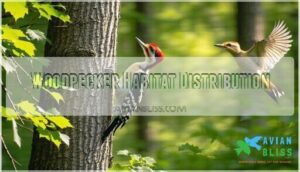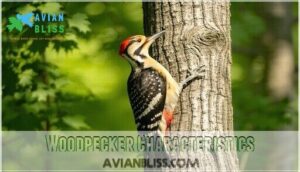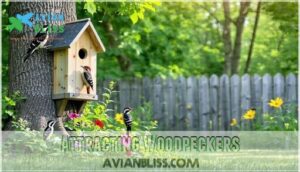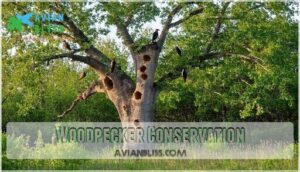This site is supported by our readers. We may earn a commission, at no cost to you, if you purchase through links.

From the common Downy and Red-bellied woodpeckers frequenting backyard feeders, to the striking Red-headed woodpecker with its crimson cap, these drummers of the tree world are fascinating to observe.
Northern Flickers prefer ground-foraging while the massive Pileated woodpecker creates distinctive rectangular holes.
The Hairy Woodpecker, Yellow-bellied Sapsucker, Lewis’s Woodpecker, and rare American Three-toed Woodpecker round out Kansas’s pecking order.
Each species has adapted uniquely to the state’s forests, prairies, and urban areas—their specialized beaks and tongues working like nature’s own carpentry tools to thrive in their environments, making them a fascinating sight to behold.
Table Of Contents
- Key Takeaways
- Kansas Woodpecker Species
- Woodpecker Habitat Distribution
- Woodpecker Characteristics
- Attracting Woodpeckers
- Woodpecker Conservation
- Frequently Asked Questions (FAQs)
- What kind of woodpeckers are in Kansas?
- What’s the difference between a woodpecker and a sapsucker?
- What does it mean when woodpeckers pecking at your house?
- Is it good to have woodpeckers in your yard?
- What is the difference between a Red-headed Woodpecker and an acorn woodpecker?
- What are the 8 species of woodpeckers in Kansas?
- Are there red-headed woodpeckers in Kansas?
- Are there Downy woodpeckers in Kansas?
- How many woodpeckers are there?
- Where do woodpeckers live?
- Conclusion
Key Takeaways
- You’ll find nine distinct woodpecker species in Kansas, including the common Downy and Red-bellied woodpeckers, the striking Red-headed woodpecker, and the rare American Three-toed Woodpecker, each with unique physical characteristics that make identification an enjoyable challenge.
- You can attract woodpeckers to your yard by installing suet feeders, planting native trees like oaks and maples, leaving dead trees standing when safe, maintaining clean water sources, and reducing pesticide use that affects their insect food supply.
- Kansas woodpeckers face conservation challenges including habitat fragmentation and climate change, with some species like the Red-headed Woodpecker experiencing population declines of up to 56% since 1966, making your preservation efforts crucial.
- You’ll notice each woodpecker species has adapted uniquely to Kansas’s diverse landscapes, from forest-dwelling Pileated Woodpeckers creating distinctive rectangular holes to ground-foraging Northern Flickers, all using specialized beaks and tongues perfectly suited to their environments.
Kansas Woodpecker Species
You’ll find nine distinct woodpecker species across Kansas, from the tiny Downy to the striking Pileated.
Each species displays unique physical characteristics and habitat preferences, making identification an enjoyable challenge for both novice and experienced birdwatchers.
Red-Bellied Woodpecker Characteristics
Red-bellied woodpeckers dart through Kansas forests with their distinctive peachy-red caps catching your eye.
Despite their name, you’ll barely notice their pale reddish wash on the belly. They’re medium-sized birds measuring 9.4 inches long with a wingspan of 13-16.5 inches.
- Males sport both red nape and crown, while females have red nape with grayish-brown crown
- Their black-and-white zebra-patterned backs create perfect camouflage against tree bark
- Weight ranges from 2.0-3.2 ounces, similar to a golf ball
- Listen for their rolling "kwirr" call to locate them before spotting their distinctive plumage details
Red-Headed Woodpecker Features
When spotting a Red-headed Woodpecker (Melanerpes erythrocephalus), you’ll immediately recognize its striking adult plumage featuring a crimson head that contrasts dramatically with its snow-white body.
At nine inches long, these birds are hard to miss.
Juvenile markings differ substantially, showing gray-brown heads instead of the distinctive head coloration.
Their black and white wing patterns create a bold visual signature that separates them from other woodpeckers in Kansas, making the Red-headed Woodpecker a notable species with its striking adult plumage.
Downy Woodpecker Identification
While the Red-headed Woodpecker dazzles with its crimson cap, the Downy Woodpecker (Dryobates pubescens) charms with its petite stature.
You’ll easily spot this tiny Kansas woodpecker by its size—smaller than a robin but larger than a sparrow.
Identifying Downy Woodpeckers becomes simple with these key features:
- Males showcase a bright red patch on their nape
- Females display all-black crowns
- Both sexes have white bellies with black-and-white striped backs
- Their small size makes them appear like chickadees with woodpecker habits
Yellow-Bellied Sapsucker Description
With striking sapsucker markings that stand out in any forest, you’ll recognize the Yellow-bellied Sapsucker by its bold red forehead and distinctive plumage details.
These medium-sized woodpeckers (7.1-8.8 inches long) are truly unique among Kansas woodpeckers.
| Feature | Males | Females |
|---|---|---|
| Crown | Bright red | Red with black mottling |
| Throat | Ruby red | White |
| Belly | Pale yellow | Pale yellow |
Northern Flicker Traits
You’ll immediately notice the Northern Flicker’s unique appearance among Kansas woodpeckers.
These fairly large Colaptes auratus measure 11-12.2 inches long with distinctive spotted bellies and black bibs.
They come in two main subspecies: Yellow-shafted (with red head markings and yellow underwings) and Red-shafted (featuring red mustache stripes).
Watch for their silvery brown plumage accented with bright markings as they hunt for their favorite diet – ants!
Hairy Woodpecker Distinctions
Looking at a Hairy Woodpecker (Dryobates villosus), you’ll notice its crisp black and white plumage variations with sharp contrast between colors.
They’re larger than their Downy cousins with noticeably longer beaks. Males display a small red patch at the back of their heads that females lack.
- Their chisel-like beaks can hammer up to 20 times per second!
- Their tongues can extend 4 inches beyond their beaks
- They’re nature’s original pest controllers, consuming thousands of wood-boring insects
- Despite their name, they don’t have actual hair—just stiff feathers on their backs
Pileated Woodpecker Markings
The magnificent Pileated Woodpecker stands out with its unmistakable triangular red crest.
You’ll recognize Dryocopus pileatus by its mostly black body with striking white stripes along the face and neck.
Males display a red cheek stripe, while females have a black one instead.
At up to 19 inches long with a 30-inch wingspan, these birds create a dramatic silhouette against Kansas trees.
Their bold plumage contrast makes woodpecker identification straightforward.
Lewis’s Woodpecker Appearance
Lewis’s Woodpecker stands out in the Kansas bird landscape with its unusual coloration.
You’ll recognize this rare visitor by:
- Deep pink-red breast and belly plumage
- Iridescent greenish-black back and wings
- Distinctive dark red face contrasting with its collar
- Crow-like flight pattern with slow, deep wing beats
- Juveniles showing duller colors and less defined markings
Though extremely uncommon in Kansas, spotting this uniquely colored woodpecker is worth the effort, due to its rare visitor status.
American Three-Toed Woodpecker Identification
When spotting the American Three-toed Woodpecker in Kansas, you’ll notice its distinctive yellow cap and contrasting black and white flanks.
This rare visitor can be identified by its clean white throat and belly.
| Feature | Description | Habitat Clues |
|---|---|---|
| Head | Yellow cap, black stripe near beak | Near water bodies |
| Body | Black wings, white throat | Summer sightings most common |
| Size | Small woodpecker | Forest edges in Kansas |
Woodpecker Habitat Distribution
You’ll find Kansas woodpeckers distributed across diverse habitats from eastern deciduous forests to western open woodlands, with species like Red-bellied and Downy Woodpeckers occupying backyards year-round.
Each species has adapted to specific ecological niches, from the Northern Flicker’s preference for forest edges to the rare American Three-toed Woodpecker’s affinity for areas near water bodies, while others like Yellow-bellied Sapsuckers only visit seasonally.
Forest Types and Woodpecker Habitats
Kansas woodpeckers thrive in diverse forest landscapes across the state.
You’ll find them in mature deciduous forests with dead standing trees, their ideal habitat.
They also populate riparian zones along waterways, coniferous forests, and even urban woodlands in well-wooded towns and parks.
Some species, like Lewis’s Woodpecker, specifically seek out burned woodlands where they can nest among fire-damaged trees.
Preferred Food Sources and Feeding Areas
Within these woodlands, you’ll find woodpeckers busy at work.
Their insect consumption forms the backbone of their diet, with beetles and ants being prime targets.
Yellow-bellied Sapsuckers show a clear sap preference, drilling neat holes in trees.
During winter diet changes, woodpeckers rely heavily on suet, which tops their favorite food list.
Seed choices include sunflower seeds and peanuts, while foraging locations vary from bark surfaces to backyard feeders.
Water Sources and Drinking Habits
While woodpeckers primarily get their food from trees and feeders, they also need water.
You’ll find these birds sipping from natural sources like streams, ponds, and puddles. They’re quite adaptable when water is scarce, often collecting dew from leaves in the morning.
Some species, particularly the Yellow-bellied Sapsucker, supplement their hydration by consuming tree sap.
If you want to attract woodpeckers to your yard, consider installing a bird bath with moving water.
Migration Patterns of Kansas Woodpeckers
After quenching their thirst, some woodpeckers in Kansas prepare for seasonal journeys while others stay put.
Migration patterns vary widely among Kansas woodpeckers:
- Red-headed woodpeckers are short-distance migrants, moving southward by mid-September when acorn supplies influence their timing
- Yellow-bellied sapsuckers visit Kansas only during winter months, escaping northern breeding grounds
- Northern flickers show variable migration, with weather conditions directly affecting their north-south movements
These migration triggers help you predict when to spot these fascinating migratory birds throughout the year. Some species like the Northern Flicker also show variable migration patterns.
Year-Round Resident Woodpeckers
While some woodpeckers migrate with changing seasons, Kansas boasts several year-round resident woodpeckers.
You’ll find the Red-bellied, Red-headed, Downy, Hairy, and Northern Flicker woodpeckers maintaining stable populations throughout all seasons.
These kansas birds have adapted to local food availability and developed winter survival strategies. Their resident habitats provide consistent nesting behaviors regardless of weather, making them reliable sightings for kansas bird identification enthusiasts any time of year, with stable populations and local food availability.
Seasonal Woodpecker Visitors
During migration seasons, Kansas becomes a dynamic stopover habitat for several woodpecker species.
You’ll notice different visitors depending on the time of year:
- Yellow-bellied Sapsuckers arrive as winter migrants, typically appearing after the first cold fronts in October
- Some Red-headed Woodpeckers exhibit partial migration triggers, moving south during harsh winters
- Climate impacts are gradually shifting traditional migration patterns, with some summer breeders arriving earlier each year
Woodpecker Characteristics
You’ll notice that Kansas woodpeckers display distinctive features from their varied head crests and unique beak shapes to their striking plumage patterns and specialized feet.
Each species has evolved remarkable adaptations for drumming, feeding, and nesting behaviors that you can observe throughout the state’s diverse habitats.
Size, Shape, and Plumage Variations
Kansas woodpeckers showcase remarkable size, shape, and plumage variations that make identifying them a fascinating challenge.
You’ll notice significant differences from the tiny Downy Woodpecker (5.5-6.7 inches) to the impressive Pileated Woodpecker (up to 19 inches).
Each species features distinctive feather patterns and plumage coloration—from red caps and black-and-white stripes to yellow bellies and crimson heads—that serve as key identifying characteristics for Kansas birds.
Behavioral Traits and Mating Habits
During spring breeding season, you’ll hear rhythmic drumming echoing through Kansas forests as woodpeckers begin their courtship rituals.
Males drum to defend territory and attract females, who evaluate their fitness as potential mates.
Once paired, they engage in mutual tapping to select nest sites and strengthen their bond.
Most species are monogamous, with both parents sharing nesting behavior responsibilities after laying 2-6 eggs that incubate for 11-14 days, which is a critical period in their breeding cycle.
Identifying Woodpecker Species
Identifying woodpecker species becomes much easier when you focus on key characteristics that distinguish one from another.
You’ll need to observe plumage patterns, size comparison, call variations, and regional differences throughout Kansas.
- Look for red patches on heads (Redbellied Woodpecker vs Redheaded Woodpecker)
- Compare overall size (tiny Downy vs robin-sized Northern Flicker)
- Listen for distinctive drumming patterns and calls
- Check for juvenile ID markers, which often differ from adults
- Note seasonal presence, as some species are year-round residents while others migrate
Unique Markings and Colorations
Woodpecker species often display striking unique markings and colorations that help you identify them at a glance.
You’ll find that plumage differences are most noticeable in the head, wings, and underbelly regions.
Here’s a quick reference table for Kansas woodpeckers:
| Species | Key Markings | Distinctive Coloration |
|---|---|---|
| Red-bellied Woodpecker | Black-white striped back | Peachy-red cap, subtle red belly |
| Red-headed Woodpecker | Solid crimson head | Snow-white body, black wings |
| Downy Woodpecker | White spotted back | Males: red crown patch |
| Yellow-bellied Sapsucker | Bold red forehead | Yellow underbelly |
| Northern Flicker | Speckled undersides | Yellow or red wing shafts |
The quick reference table provides a concise overview of the different species, making it easier to distinguish between them based on their distinctive coloration and key markings.
Beak Shapes and Sizes
The chisel-like tools on woodpeckers’ faces reveal much about their feeding habits.
You’ll notice dramatic differences in beak shapes and sizes across Kansas woodpecker species.
Downy Woodpeckers sport shorter, more delicate beaks perfect for precision work, while Pileated Woodpeckers wield heavy-duty excavation equipment.
These drilling mechanics have evolved specifically for each bird’s preferred diet and feeding adaptations, making beak morphology a key identifier when spotting these remarkable birds.
Bird beaks, composed of continuously growing keratin, are essential tools.
Wing Patterns and Flight Styles
While woodpecker beaks are specialized for drilling, their wing patterns and flight styles are equally fascinating.
Kansas woodpeckers display distinctive flight adaptations that help with species identification.
Watch for these flight characteristics:
- The Northern Flicker’s distinctive undulating "roller-coaster" flight path
- Downy Woodpecker’s quick, jerky movements between trees
- Hairy Woodpecker’s direct, purposeful flight with deeper wing beats
- Most woodpeckers’ unique "flap-flap-glide" pattern unlike other birds
Wings typically show bold patterns visible during flight.
Attracting Woodpeckers
You’ll transform your Kansas backyard into a woodpecker haven with the right combination of food sources, native plants, and suitable habitat features.
Creating an environment that meets these remarkable birds’ specific needs won’t just attract all nine local species but will also let you observe their fascinating drumming, feeding, and nesting behaviors up close, allowing for a unique experience with remarkable birds.
Types of Woodpecker-Friendly Plants
Now that you know how to identify Kansas woodpeckers, let’s look at plants that’ll bring them to your yard.
Native berry bushes like elderberry and dogwood provide excellent food sources. Plant insect-attracting trees such as oak and maple, which naturally harbor beetle larvae—a woodpecker favorite.
Nut-bearing species like hickory support woodpecker diet needs, while sap-producing plants attract Yellow-bellied Sapsuckers.
Consider purchasing berry bushes for your yard. Don’t forget to include snag trees for nesting sites!
Feeding Woodpeckers: Seed Types and Feeder Options
While Kansas woodpeckers won’t flock to just any bird feeders, they’ll become regular visitors with the right menu.
Popular species like Downy and Hairy woodpeckers readily visit backyard stations offering:
- High-energy suet varieties in log-shaped or cage feeders, especially nut and berry blends in winter
- Black oil sunflower seeds presented in tube, hopper, or platform feeders
- Peanut feeders filled with unsalted nuts that satisfy their natural foraging instincts
To attract more woodpeckers, consider offering food when families have fledglings.
Creating Woodpecker-Conducive Environments
Creating a backyard haven for woodpeckers doesn’t require fancy equipment.
You’ll need to focus on these essential elements to transform your yard into a woodpecker paradise.
| Habitat Element | How to Implement | Benefits | Species Attracted |
|---|---|---|---|
| Natural Nesting | Leave dead trees/limbs | Provides homes | All Kansas species |
| Native Trees | Plant oaks, maples | Food source | Red-bellied, Downy |
| Water Availability | Install bird baths | Hydration | All woodpeckers |
| Reducing Pesticides | Go organic | Increases insect abundance | Sapsuckers, Flickers |
Consider adding specialized bird baths designed for woodpeckers to create a woodpecker paradise with native trees and natural nesting areas, which will attract various species, including Red-bellied and Downy woodpeckers.
Avoiding Woodpecker Repellents
Now that you’ve created an ideal environment, let’s talk about what not to do.
When attracting Kansas wildlife to your yard, skip harsh chemical repellents that harm woodpecker species.
Instead, if woodpeckers become problematic, try natural deterrents like wind chimes or shiny objects.
Visual scare tactics work without endangering birds.
Remember, habitat modification is more effective than exclusion methods—providing alternative food sources away from your home creates harmony while identifying woodpeckers becomes easier in a welcoming space.
Maintaining Woodpecker-Friendly Yards
Regular maintenance of your yard creates a woodpecker paradise. Leave dead trees standing when safe to provide nesting habitats and insect food sources.
Leave dead trees standing when safe—they’re five-star woodpecker hotels with all-you-can-eat insect buffets!
Use only safe pesticides or avoid them completely—woodpeckers need those insects! Install bird feeders with suet and maintain clean water availability year-round.
Consider using specialized suet feeders to attract woodpeckers. Plant native plants that attract insect populations.
Remember, a slightly messy yard with natural elements makes the perfect woodpecker habitat for Kansas backyard birds.
Woodpecker Conservation
You’ll directly contribute to Kansas woodpecker survival by maintaining dead trees on your property.
Your awareness of habitat fragmentation and climate change impacts helps protect these remarkable birds for future generations to enjoy, and by supporting local conservation programs, you further ensure their survival, which is crucial for future generations.
Habitat Loss and Fragmentation
Woodpecker populations are hanging by a thread as forest fragmentation carves up their natural habitat.
You’ll notice fewer drumming sounds as urbanization impact eliminates essential nesting sites in Kansas woodlands.
Habitat loss directly affects food availability, with specialist species suffering most in fragmented forests.
Conservation strategies now focus on connecting isolated woodpecker habitats across forests and even arid locations, preserving the scattered woodland patches these birds need to survive, which is crucial for their survival in fragmented forests.
Effects of Climate Change on Woodpeckers
While habitat loss threatens woodpeckers directly, climate change is quietly reshaping their world too.
Kansas’s warming climate is pushing Red-bellied Woodpeckers northward, creating new competition dynamics.
Red-headed Woodpeckers face severe population declines—down 56% since 1966.
Climate impacts manifest in several ways: fluctuating insect populations disrupt feeding patterns, earlier breeding seasons create food mismatches, and increasingly violent storms destroy the mature trees woodpeckers depend on for nesting.
Conservation Efforts and Restoration Programs
How are we safeguarding Kansas’s drumming denizens? The Kansas Department of Wildlife and Parks has implemented a successful Woodpecker Conservation Program that’s increased populations by 15% over the past decade.
This multifaceted initiative focuses on habitat preservation and reforestation projects for Kansas native birds.
- Creating artificial nesting assistance sites for woodpecker species
- Restoring natural habitats with native trees and shrubs
- Combating invasive species that threaten woodpecker behavior
- Raising public awareness through wildlife education programs
Protecting Woodpecker Populations
Kansas’s feathered drummers face increasing threats in 2025.
You can help protect woodpecker populations through habitat preservation of dead trees for nesting and insect-rich environments.
Reduce pesticide use to maintain their food sources, and support sustainable forestry practices that preserve their habitats.
The Apache-Sitgreaves National Forest provides diverse woodpecker habitats for several species.
Your participation in citizen science programs helps track woodpecker behavior, sounds, and species distribution—providing essential data for targeted conservation strategies.
Research and Monitoring Initiatives
Scientists are tracking our feathered friends right in your backyard.
Join citizen science initiatives where your kansas birdwatching observations contribute valuable data collection for population trends.
Since 2008, researchers have monitored woodpecker nesting habits, revealing critical habitat studies information.
You’ll find layered, question-driven research throughout kansas ornithology projects that measure conservation impact on common kansas birds.
Your participation helps maintain the kansas bird guide’s accuracy while supporting scientific advancement.
You can also contribute to biological inventory research by participating in local projects, which is a great way to support citizen science initiatives and conservation impact.
Community Involvement and Education
You can pitch in for Kansas woodpecker conservation through community science and education.
Local partnerships have created excellent resources for backyard birding enthusiasts.
Here’s how to get involved:
- Join citizen science projects like Kansas Bird Atlas
- Attend educational programs at nature centers
- Partner with conservation advocacy groups
- Improve your bird identification skills through Kansas bird guide workshops
Frequently Asked Questions (FAQs)
What kind of woodpeckers are in Kansas?
You’ll be amazed to discover seven woodpecker species in Kansas. You can spot Red-bellied, Red-headed, Downy, Hairy, Pileated, and Northern Flicker year-round, while Yellow-bellied Sapsuckers appear during winter months.
What’s the difference between a woodpecker and a sapsucker?
Woodpeckers drill for insects while sapsuckers create neat rows of holes to collect sap.
You’ll notice sapsuckers have specialized brush-like tongues and typically feed on tree fluids rather than boring for bugs.
What does it mean when woodpeckers pecking at your house?
Like nature’s home inspectors, drumming on your house means woodpeckers are either searching for insects in your siding, creating a territory signal, or building a nesting cavity.
You’ll need to deter them quickly.
Is it good to have woodpeckers in your yard?
Having woodpeckers in your yard is beneficial as they control insect populations, especially wood-boring pests. You’ll enjoy their vibrant presence while they naturally maintain tree health in your landscape.
What is the difference between a Red-headed Woodpecker and an acorn woodpecker?
You’ll notice Red-headed Woodpeckers have an entirely crimson head with black-white body, living in eastern forests.
Acorn Woodpeckers sport a clown-like face with black-white-red pattern and wild white eyes, dwelling communally in western oak woodlands.
What are the 8 species of woodpeckers in Kansas?
Just as you’re exploring Kansas, you’ll discover eight spectacular woodpecker species: Red-bellied, Red-headed, Hairy, Downy, Northern Flicker, Yellow-bellied Sapsucker, Pileated, and the rare Lewis’s Woodpecker. They’re waiting for your binoculars!
Are there red-headed woodpeckers in Kansas?
Yes, you’ll find Red-headed Woodpeckers in Kansas year-round.
They’re especially common during summer months, with breeding populations throughout the state.
Look for their distinctive crimson heads and black-and-white patterned wings in wooded areas.
Are there Downy woodpeckers in Kansas?
You’ll find Downy woodpeckers throughout Kansas year-round. They’re the smallest native woodpecker species, frequently visiting backyards, parks, and woodlands across the state. Look for their distinctive black and white pattern.
How many woodpeckers are there?
To put it briefly, Kansas is home to seven distinct woodpecker species. You’ll find the Downy, Hairy, Red-bellied, Red-headed, Northern Flicker, Yellow-bellied Sapsucker, and rarely, the Pileated Woodpecker.
Where do woodpeckers live?
Woodpeckers typically make their homes in forests, woodlands, and urban areas with trees.
You’ll find them drilling nest cavities in dead trees or branches, where they’ll raise their young and seek shelter, which is a complete concept of their habitat and behavior.
Conclusion
As the saying goes, "The early bird gets the worm," but in Kansas, it’s the woodpeckers that truly demonstrate this wisdom.
Whether you’re exploring eastern forests or western plains, you’ll discover the woodpeckers of Kansas bring forests to life with their distinctive drumming and flashes of color.
By understanding their habits and creating welcoming spaces, you’ll transform your backyard into a woodpecker haven.
Start your birdwatching journey today—these remarkable architects of the tree world await!







